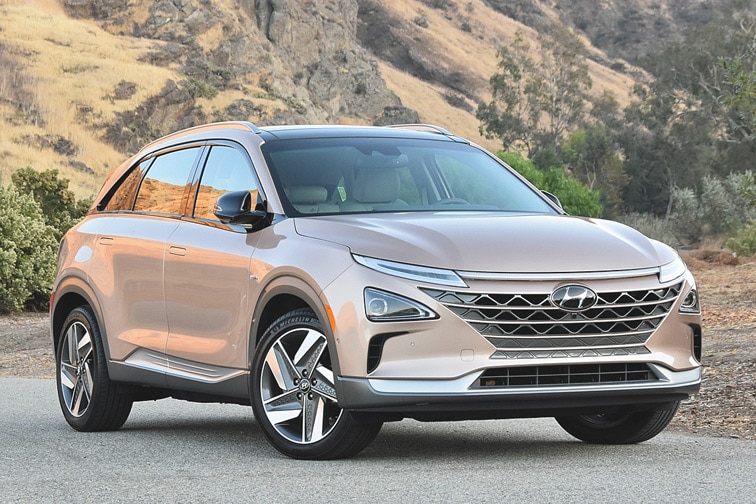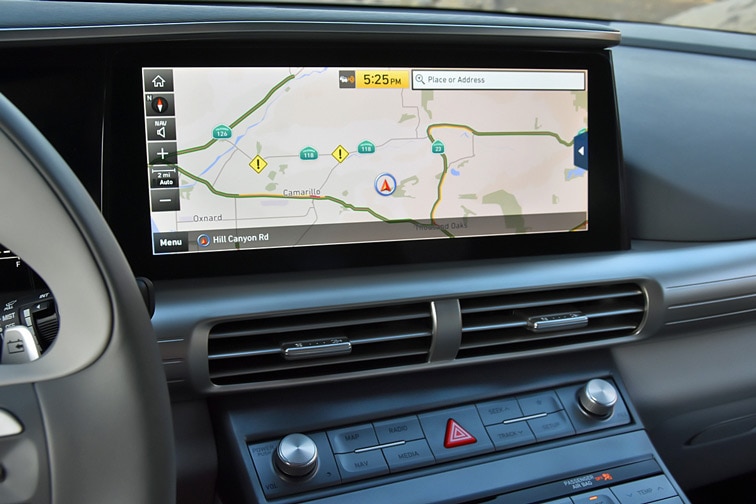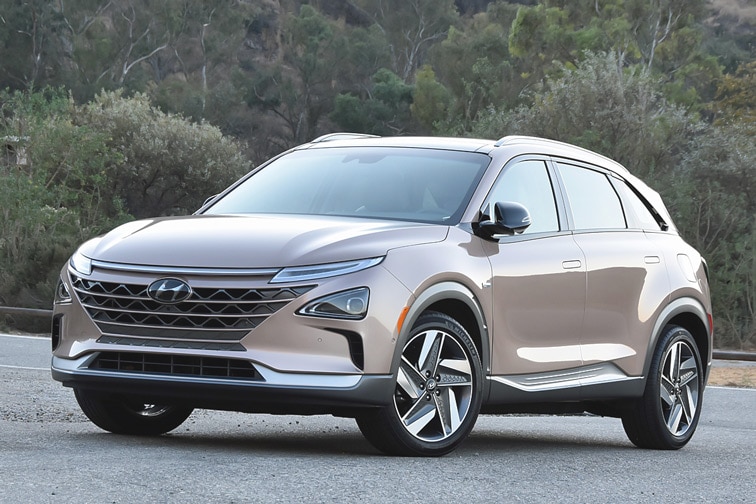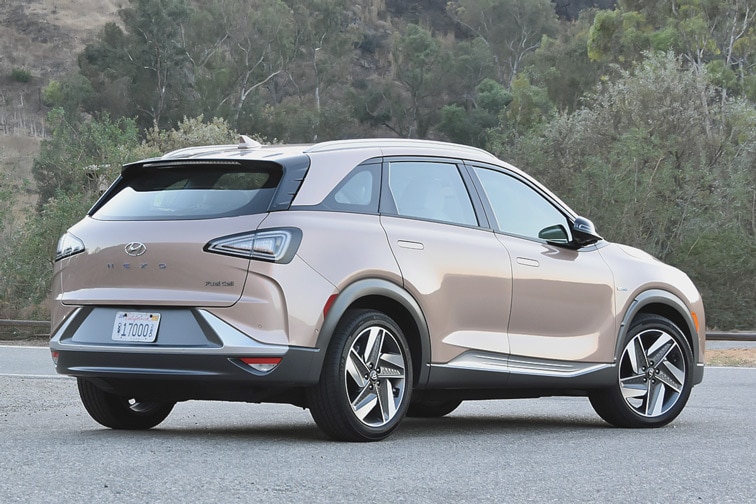2020 Hyundai Nexo Review: Today’s Hyundai, Tomorrow’s Tech
Hydrogen-powered fuel cell electric vehicles will be a part of the future. This one’s available today.
 Christian Wardlaw
Christian Wardlaw
Hyundai’s most serious foray yet into using hydrogen as a viable fuel source is the 2020 Nexo fuel cell electric vehicle (FCEV). For those unfamiliar with FCEVs, they’re essentially electric vehicles, but instead of large batteries, they use state-of-the-art onboard systems that use hydrogen to generate electricity. That’s a big deal, since they can literally
The Hyundai Nexo isn’t the only FCEV on the market: Honda’s Clarity Fuel Cell and Toyota’s Mirai have both been on the road for a couple years now. It is, however, a crossover SUV, with all the daily life utility that you’d expect from any other crossover. With that in mind, Hyundai let me borrow a Nexo for seven days of kid hauling, grocery getting, and errand running. As it turns out, the experience was mostly enjoyable and almost totally painless.
 Christian Wardlaw
Christian Wardlaw
A FUTURISTIC EXERCISE IN AUTOMOTIVE INTERIOR DESIGN
From the design and quality of materials to the unusual controls and high-tech displays, the Nexo looks appropriately futuristic. Slide into the driver’s seat, and the FCEV bears little resemblance to fellow Hyundais.
Two tablet-style widescreens are propped up on the dash’s silver metallic trim, a look similar to modern Mercedes-Benz design. A control bridge juts from below the center vents, extending a collection of buttons and knobs between the front seats. They’re angled at the ceiling and finished in a way that makes them somewhat hard to read, especially at sunrise and sunset. Storage below the bridge is generous but difficult to access, and includes a wireless smartphone charger. Aside from the information displays and the intuitive controls on the two-spoke steering wheel, the Nexo’s interior is largely an exercise in design, rather than a case study on intuitive use.
Comfort, however, abounds. Both front seats offer power height adjustment, and the Limited trim test vehicle included heated and ventilated cushions, as well as a heated steering wheel. The rear seat cushion provides excellent support, and the flat floor means three people can ride with relative ease. The seating hip points are also high, making it easy to get into and out of the Nexo.
Cargo space is on par with small crossover SUVs. The Nexo has 29.6 cubic feet of volume behind the rear seat, and 56.5 cu.-ft. with the back seat folded flat. The trunks of its FCEV rivals, Honda Clarity Fuel Cell (11.8 cu.-ft.) and Toyota Mirai (12.8 cu.-ft.), are dwarfed by comparison.
 Christian Wardlaw
Christian Wardlaw
A HIGH-TECH HYUNDAI
Several of Nexo's technologies are worthy of mention. The 12.3-inch widescreen infotainment system is outstanding, with a minimalist home screen and menu shortcuts easily accessed by swiping right and left. This design, the stereo controls on the steering wheel, the voice recognition technology, and the dual-zone automatic climate system work together so seamlessly that you can mostly ignore the buttons on the control bridge.
The Nexo also has unique displays and data panels dedicated to monitoring your fuel cell operation. The navigation system gives the direction of the nearest hydrogen station, and there is a range display showing on a map how much farther you can drive on the remaining fuel.
With Limited trim, the Nexo is equipped with a Krell high-end audio system, a surround-view camera system, and Hyundai’s Blind-Spot View Monitor (BSVM). The BSVM provides a live video feed to supplement the SUV’s standard blind spot monitoring system. While Hyundai’s approach is more user-friendly than comparable systems from rivals, it’s still more gimmick than useful.
Similarly, the Nexo Limited’s Remote Smart Parking Assist (RSPA) system isn't terribly practical—even if it’s as good as systems from several premium brands. It allows you to park a Nexo in a perpendicular space while standing outside of the SUV, and then retrieve it from that same space. But until all vehicles are autonomous, this technology nods more to tomorrow’s possibilities than to today’s needs.
The Nexo’s advanced driving assistance systems (ADAS) are another story. Not only are they useful, but they also operate with such a degree of accuracy and refinement that I was inclined to keep them engaged rather than shut them off. Should an accident occur, know that the Hyundai Nexo is rated a “Top Safety Pick+” by the
 Hyundai
Hyundai
HOW THE NEXO’S FUEL CELL WORKS
Driving an FCEV is like driving an electric car and is accompanied by a subtle, Jetsons-esque whine. You can only hear it at low speeds, especially when the windows are down, and it makes the Nexo sound special.
Hydrogen fuel flows from the tank to the Nexo’s 95 kW fuel cell stack. There, the stack separates the hydrogen into ions and electrons. The ions then pass through a semipermeable membrane, leaving the electrons behind to do the heavy lifting. Those abandoned electrons route into the 40-kW lithium-ion battery, powering the 120-kW electric motor before rejoining the ions in a separate part of the fuel cell. They, combined with oxygen from the air intake, form the only byproducts of the electrochemical process: heat and water vapor. If that sounds complex, that’s because it’s still cutting-edge tech. For a deeper dive into how the hydrogen fuel cell operates,
 Christian Wardlaw
Christian Wardlaw
DRIVING THE NEXO IS A GENUINE PLEASURE
With 161 horsepower and 291 lb.-ft. of instantaneous torque flowing to the front wheels, the Nexo feels lively, even at low speeds. It accelerates quickly, pushing you back into your seat for a truly enjoyable drive.
Under normal conditions, the Nexo handles beautifully. Suspension tuning masks the weight of the drivetrain components, and while the ride is somewhat soft the Nexo always feels solid and connected to the road. The steering assist can seem a little artificial, rubbery, and oddly-weighted, and the regenerative brakes sometimes grab too much in traffic, but it’s easy to acclimatize to both traits while whooshing about town.
On the freeway, the Nexo effortlessly cruises at 80 mph, with enough power in reserve to climb mountain grades and pass slower vehicles. It’s nearly silent at speed, too. The only sounds infiltrating the cabin are a hint of wind and a slight amount of road noise.
Hustle the Nexo on a twisty road, though, and it loses some of its composure, especially if the pavement undulates. Higher velocity dips discombobulate the Nexo, and can cause it to bob and weave more than is desirable. Then again, Hyundai didn’t set out to build the best sporty SUV with the Nexo. It set out to build the best fuel cell electric vehicle.
And it succeeded.
 Christian Wardlaw
Christian Wardlaw
A FANTASTIC, NO-COMPROMISE FUEL CELL ELECTRIC VEHICLE
The Hyundai Nexo itself is fantastic, a no-compromise FCEV with five-passenger seating capacity, plenty of trunk and cargo space, and an impressive load of luxury features and high-tech gadgets. It isn’t cheap, though, with a starting price of $58,735. But the federal government, the state of California, and Hyundai take some of the sting out of that window sticker.
At the time of publication, Nexo buyers are eligible for up to a $7,500 federal income tax credit for doing so. The state of
THE VERDICT: TECH IS READY, INFRASTRUCTURE IS NOT
The main problem with using the Nexo as a daily driver has little to do with the vehicle itself. The Nexo demonstrates that fuel cell technology works. Rather, it’s that the hydrogen fuel cell is a powertrain of the future that has to contend with 2020’s lack of infrastructure. As of May 2020, there are just over 40 hydrogen refueling stations in the U.S., and almost all of them are in California.
No doubt, this situation will improve over time, and one day, swinging by a hydrogen pump will likely prove as simple an experience as gasoline has been for decades.
KEY VEHICLE STATS:
2020 Hyundai Nexo
Trim: Limited
MSRP*:
Base: $62,185
As Tested: $62,185
Selected Specifications:
Fuel Economy (city/hwy/combined): 59 MPGe, 54 MPGe, 57 MPGe
Power: 161 hp
Torque: 291 lb.-ft.
Seating Capacity: 5
Advanced Safety Systems:
Lane Follow Assist – Centers the Nexo in the lane of travel.
Blind-Spot View Monitor – Shows camera view of blind spots.
Other Key Trims:
Blue: $58,735*
*MSRP does not include $1,120 destination fee.
Written by humans.
Edited by humans.
 Christian Wardlaw
Christian WardlawChris says his first word was "car." For as long as he can remember, he's been obsessed with them. The design. The engineering. The performance. And the purpose. He is a car enthusiast who loves to drive, but is most passionate about the cars, trucks, and SUVs that people actually buy. He began his career as the editor-in-chief of Edmunds.com in the 1990s, and for more than 30 years has created automotive content for CarGurus, J.D. Power, Kelley Blue Book, the New York Daily News, and others. Chris owns Speedy Daddy Media, has been contributing to Capital One Auto Navigator since 2019, and lives in California with his wife, kids, dog, and 2004 Mazdaspeed Miata.
Related articles
View more related articles